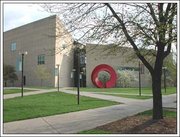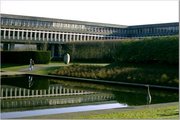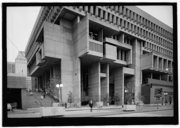Brutalism
|
|
Missing image Unite_d'Habitation_(Rightee_2).jpg Unité d'Habitation, Marseilles (Le Corbusier 1952) |
Missing image Trellicktower.jpg Trellick Tower, London (Goldfinger 1972) |
Missing image SouthBankCentre02.jpg Royal National Theatre, London (Lasdun 1976) |
Missing image Regenstein_Library,_University_of_Chicago.jpg Regenstein Library, Chicago (Netsch 1970) |
Missing image Cameron_Offices_-_Speck_2_-_Detail.jpg Cameron Offices (detail), Canberra (Andrews 1972) |
Missing image Trsunset.jpg Tricorn Centre, Portsmouth UK (Luder 1964) |
Missing image HomeOffice_QueenAnnesGate.jpg Home Office building, London (Spence 1976) |
Missing image Rees_memorial_carillon.jpg Thomas Rees Memorial Carillon, Springfield, Illinois (Turley 1962) |
 Indiana University Art Museum, Bloomington, Indiana (Pei 1972) |
Brutalism is an architectural style that spawned from the Modernist architectural movement and which flourished from the 1950s to the 1970s. The early style was largely inspired by the work of Swiss architect, Le Corbusier (in particular his Unité d'Habitation building) and of Ludwig Mies van der Rohe. The term originates from the French béton brut, or "raw concrete". Brutalist buildings are usually formed with striking blockish, geometric, and repetitive shapes, and often revealing the textures of the wooden forms used to shape the material, which is normally rough, unadorned poured concrete.
Brutalism as an architectural style was also associated with a social utopian ideology which tended to be supported by its designers, especially Peter and Alison Smithson, near the height of the style. The failure of positive communities to form early on in some Brutalist structures, possibly due to the natural urban decay of the post-WWII period (especially in the United Kingdom), led to the combined unpopularity of both the ideology and the architectural style.
| Contents |
Style
Brutalism is related and similar to (and often confused with) the Modernist, Minimalist and Internationalist styles of architecture. All of these styles make heavy use of repetition and regularity in their features, but brutalist designs also often incorporate striking, abject irregularities as well.
Another common theme in brutalist designs is the exposition of the building's functions -- ranging from their structure and services to their actual human use -- in the exterior of the building. In other words, Brutalist style is "the celebration of concrete." In the Boston City Hall (illustration left), strikingly different and projected portions of the building indicate the special nature of the rooms behind those walls, such as the mayor's office or the city council chambers. From another perspective of this theme, the design of the Hunstanton Secondary School included placing the facility's water tank, a normally hidden service feature, in a prominently placed and visible tower.
Critics note that this abstract nature of Brutalism makes the style unfriendly and uncommunicative, instead of integrating and protective as its proponents intended. For example, the location of the entrance of a Brutalist structure is rarely obvious to the visitor.
Brutalism is also criticised for its disregard for the social, historic, and architectural environment of its surroundings, making the introduction of such structures in existing developed areas appear very stark, out of place, and alien.
History
Brutalism gained large momentum in Britain during the middle 20th century, as economically depressed (and WWII-ravaged) communities sought inexpensive construction and design methods for low-cost housing, shopping centers, and government buildings. Combined with the socially progressive intentions behind brutalist "streets in the sky" housings like Corbusier's Unité, brutalism was promoted as a positive option for forward-moving, modern urban housing. In practice however, many of the buildings lacked many of the community-serving features of Corbusier's vision, and instead developed into claustrophobic, crime-ridden tenements. Some such buildings took decades to develop into positive communities. The rough coolness of concrete lost its appeal under a damp and gray northern sky, and its fortress-like material touted as vandalproof soon proved vulnerable to spray-can graffiti.
Brutalist designs were also often initially criticised as eyesores. The current Fodor's guide to London mentions the Home office structure as "hulking." Because the style is essentially that of poured concrete it tends to be inexpensive to build and maintain (but very difficult to modify). However, in the case of Trellick Tower, the design has ultimately proved very popular with both tenants and owner-occupier residents. In time, many brutalist structures become appreciated as landmarks by their communities for their uniqueness and eye-catching appearance.
In recent years, the bad memories of underserved Brutalist community structures have led to their eager demolition to make way for newer, more traditionally oriented community structures. Despite a nascent Modernist appreciation movement, and the identified success that some of this style's offspring have had, many others have been or are slated to be demolished.
"The New Barbarism"
Brutalism has some severe critics, one of the most famous being Charles, Prince of Wales, whose speeches and writings on architecture have excoriated brutalism. The architecture column of Private Eye, "Nooks and Corners", began life as "Nooks and Corners of the New Barbarism", with "new barbarism" clearly intended as a reference to "new brutalism". The column is skeptical about modern architecture in general, but over the course of some four decades has reserved its strongest wrath for brutalism, especially in government-sponsored projects.
Figures
Architects associated with the brutalist style include Erno Goldfinger, husband-and-wife pairing Peter and Alison Smithson, and, to a lesser extent perhaps, Sir Denys Lasdun. Outside of Britain, Louis Kahn's government buildings in Asia and John Andrews's government and institutional structures in Australia exhibit the creative height of the style. More recent Modernists such as I.M. Pei and Tadao Ando have also designed notable Brutalist works.
List of brutalist structures
(Structure name, location, architect(s), year built)
- Balfron Tower, West London, UK (Ernö Goldfinger, 1971)
- The Barbican, London, UK
- Berkshire House, Toronto, Ontario
- Boston City Hall, Boston, Massachusetts (I.M. Pei/Kallmann, McKinnell & Knowles/Campbell, Aldrich & Nulty, 1969)
- Brantford City Hall, Brantford, Ontario (Michael Kopsa, 1966)
- Le Brasilia, Marseille, France (F. Boukobza, 1966)
- Brunel University Uxbridge Campus, London, United Kingdom, 1966. The Lecture Centre is possibly the finest remaining example of Brutalist Architecture in the UK
- Brunswick Centre, London, UK (Patrick Hodgkinson, 1972)
- Buffalo City Court, Buffalo, New York (Phohl, Roberts and Biggie, 1964)
- Cameron Offices, Canberra, Australia (John Andrews, 1972) (demolished 2002)
- Carpenter Center, Harvard University, Boston, Massachusetts (Le Corbusier, 1963)
- Chapel on Mount Rokko, Kobe, Japan (Tadao Ando, 1986)
- Chapel on the Water, Hokkaido, Japan (Tadao Ando, 1988)
- Chateau Granville hotel, Vancouver, British Columbia (unknown, 1977)
- Genex Tower, Belgrade, Serbia (Mihajlo Mitrovic,1980)
- George Crawford Manor, New Haven, Connecticut (Paul Rudolph, 1966)
- Crosley Tower, University of Cincinnati, Cincinnati, Ohio (A. M. Kinney, 1969)
- Dewan Tunku Canselor, University of Malaya, Kuala Lumpur, Malaysia (Datuk Kington Loo, unknown)
- The Evergreen State College, most administrative buildings, Olympia, Washington (various, 1971-1977)
- Freeway Park, Seattle, Washington, (Lawrence Halprin, 1972–1976)
- Front Hi-Rise, St. Paul, Minnesota (Freerks, Sperl, & Flynn, 1969)
- Group Residence for Young Adults, Manhattan (Horace Ginsbern & Associates, 1968) (possibly demolished)
- Habitat 67, 1967 World's Fair, Montreal, Quebec (Moshe Safdie, 1967)
- Hayward Gallery, London, UK (Dennis Crompton/Warren Chalk/Ron Herron, 1968)
- High Court building, Canberra, Australia (Edwards Madigan Torzillo and Briggs, 1980)
- Home Office Building, London, UK (Sir Basil Spence, 1976)
- J. Edgar Hoover Building, Federal Bureau of Investigation Headquarters Washington, D.C. (Charles F. Murphy and Associates, designed 1964, completed 1974)
- Hunstanton Secondary School, Norfolk, UK (Peter and Alison Smithson, 1954)
- Indiana University Art Museum, Bloomington, Indiana (I.M. Pei, 1982)
- Islamic Cultural Center, Manhattan
- Jatiyo Sangsad Bhaban (Dhaka National Assembly), Dhaka, Bangladesh (Louis Khan, 1982 (designed 1962)
- Herbert F. Johnson Museum of Art (Cornell University), Ithaca, New York (I.M. Pei, 1973)
- Kanchanjunga Apartments, Mumbai, India (Charles Correa, 1974)
- King George Tower, Sydney, Australia (John Andrews, 1976)
- Kingsbury Apartments, Trenton, New Jersey
- Lauderdale Tower, London, UK (Chamberlin, Powell & Bon, 1974)
- Manhattan Church of Christ, Manhattan (unknown, 1968)
- St. Mary of Nazareth Hospital Center, Chicago
- Middleton Grange Shopping Centre, Hartlepool (unknown, 1968)
- Daniel Morits Towers, Tel Aviv-Yaffo, Israel
- Moore Office Building, Vancouver, British Columbia (Blair MacDonald, 1968) (demolished)
- Mummers Theater, Oklahoma City, Oklahoma (John M. Johansen, 1970)
- Oklahoma State Department of Health, Oklahoma City, Oklahoma
- Chapel of Notre Dame du Haut, Ronchamp, France (Le Corbusier, 1956)
- Pan Am Building, New York (Emery Roth & Sons, 1963)
- Park Hill, Sheffield, UK (Ivor Smith/Jack Lynn, 1961)
- Queen Elizabeth Hall, London, UK (unknown, 1967) (demolition planned)
- Thomas Rees Memorial Carillon, Springfield, Illinois (Fred Turley, 1962)
- Regenstein Library, University of Chicago, Chicago, Illinois (Walter Netsch, 1970)
- Riverside Plaza Buildings (McKnight Tower Apartments, Chase House Apartments, Towers B, D, E, and F), Minneapolis, Minnesota (Ralph Rapson, 1973)
- John P. Robarts Research Library, Toronto, Ontario (A.S. Mathers and E.J. Haldenby, 1973)
- Rochdale College, Toronto (Tampold and Wells, 1968)
- Robin Hood Gardens, London, UK (Peter and Alison Smithson, 1972?)
- Rochester Institute of Technology, Rochester, New York
- Rokko Housing One, Kobe, Japan (Tadao Ando, 1983)
- Royal National Theatre, London, UK (Sir Denys Lasdun, 1976)
- Monastery of Saint Marie de la Tourette, Eveux-sur-Arbresle, France (Le Corbusier, 1960?)
- Simon Fraser University, most buildings and plazas, Burnaby, British Columbia (Arthur Erickson/Geoffrey Massey et. al., 1965)
- St Peter's Seminary, Cardross, Scotland (Gillespie, Kidd & Coia, 1966)
- Tartu College, Toronto (Tampold and Wells, 1969)
- Tel Aviv City Hall House, Tel Aviv, Israel (unknown, 1966)
- Trellick Tower, London, UK (Erno Goldfinger, 1972)
- Tricorn Centre, Portsmouth, UK (Owen Luder, 1964)(demolished 2004)
- Unité d'Habitation de Marseille (Cité Radieuse), Marseille, France (Le Corbusier, 1952)
- Unité d'Habitation de Nantes, Marseille, France (Le Corbusier, 1955)
- Unité d'Habitation (Corbusierhaus), Berlin, Germany (Le Corbusier, 1956-1959)
- Unité d'Habitation de Briey en Forêt, Briey en Forêt, France (Le Corbusier, 1956-1963)
- Unité d'Habitation Les Bruneaux, Firminy, France (Le Corbusier, 1967)
- United States Tax Court, Washington, D.C., 1974
- University of California, Berkeley, numerous buildings, Berkeley, California (Joseph Esherick?, unknown)
- University of California, Irvine, most original buildings, Irvine, California (William Pereira and Associates, 1960s)
- Student Residences, University of Canberra, Canberra, Australia (John Andrews, 1975)
- University of Minnesota, Moos Health Sciences Tower and Phillips Wangensteen Building, Minneapolis, Minnesota (Hammel, Green & Abrahamson, 1974)
- University of Washington, some dormitories, Seattle, Washington
- Engineering & Math Sciences building, University of Wisconsin, Milwaukee, Milwaukee, Wisconsin (Grelinger, Rose, Klumb, Jurenec, Hass, 1971)
- Weldon Library, University of Western Ontario, London, Ontario (Ronald E. Murphy/John Andrews, 1972)
- Wells Fargo Building, Milwaukee, Wisconsin (1969)
- Robert W. Woodruff Library (Geoffrey Freeman?, 1969) and other buildings (unknown, 1974-77), Emory University, Atlanta, Georgia
- numerous government and office buildings in Basingstoke, UK (unknown, 1970s); also the Basingstoke Town Centre (late 1960s) (demolished)
- the support columns of the Seattle Monorail track (ALWEG, 1962) have been identified as "brutalist"
- numerous highway elevation projects in the United States from the late 1960s and 1970s resemble brutalist designs for their use of stark, blocky concrete shapes
See also
External links
- Ontario Architecture: Brutalism (http://www.ontarioarchitecture.com/Brutalist.htm)
- From Here to Modernity (http://www.open2.net/modernity/inner_frameset.htm) includes many Brutalist examples
- Sarah J. Duncan (http://www.sarahjduncan.com/brutalism.html) photos of brutalist structures
- Charles Mudede, "Topography of Terror (http://www.thestranger.com/2002-08-22/feature.html)", The Stranger (newspaper) (Seattle), Vol 11 No. 49, Aug 22–Aug 28 2002. fa:زبرهکاری



